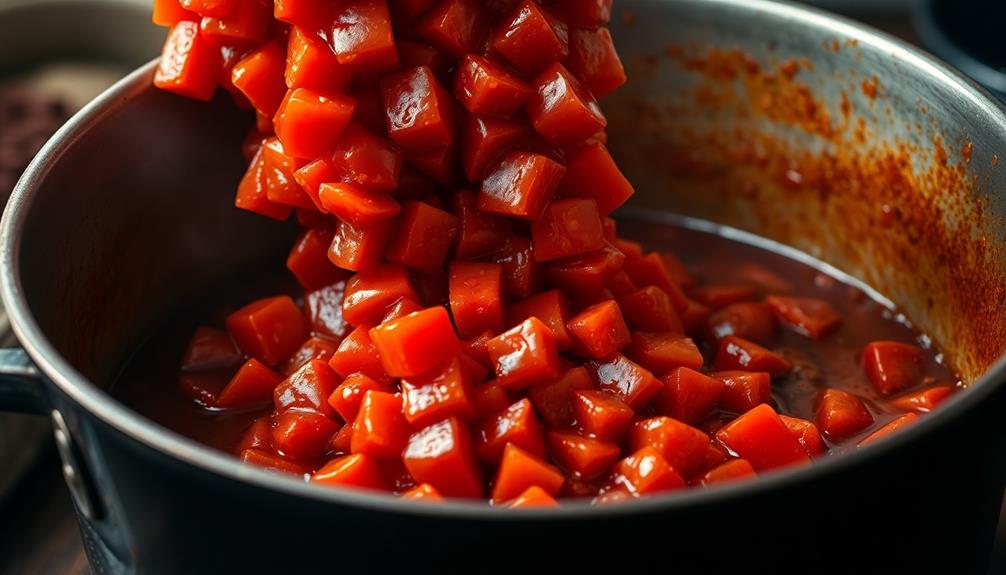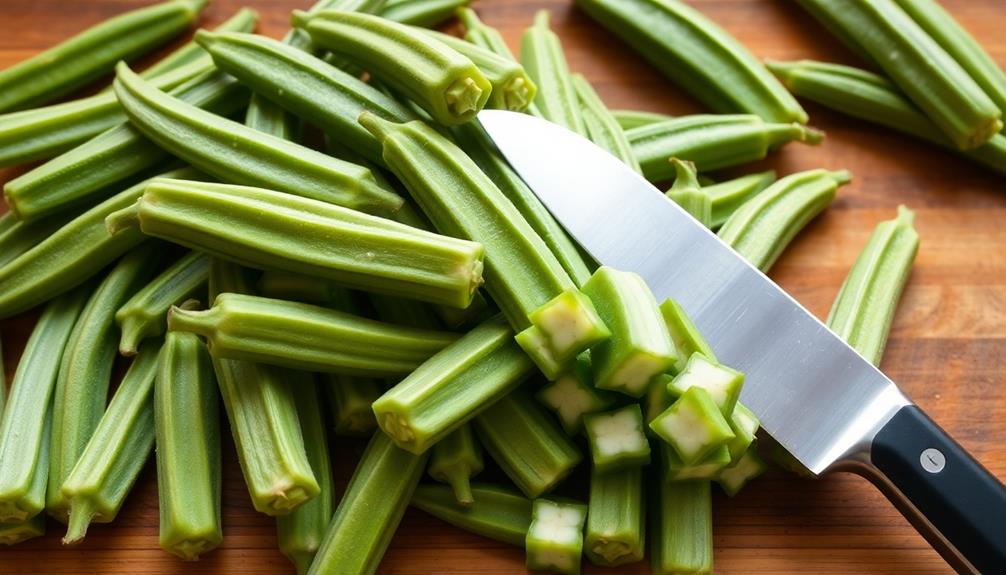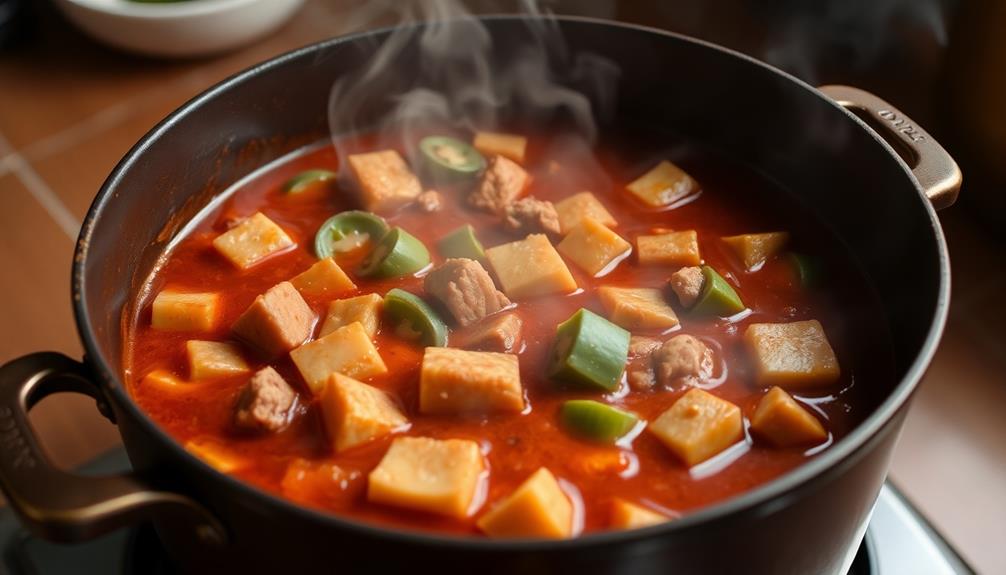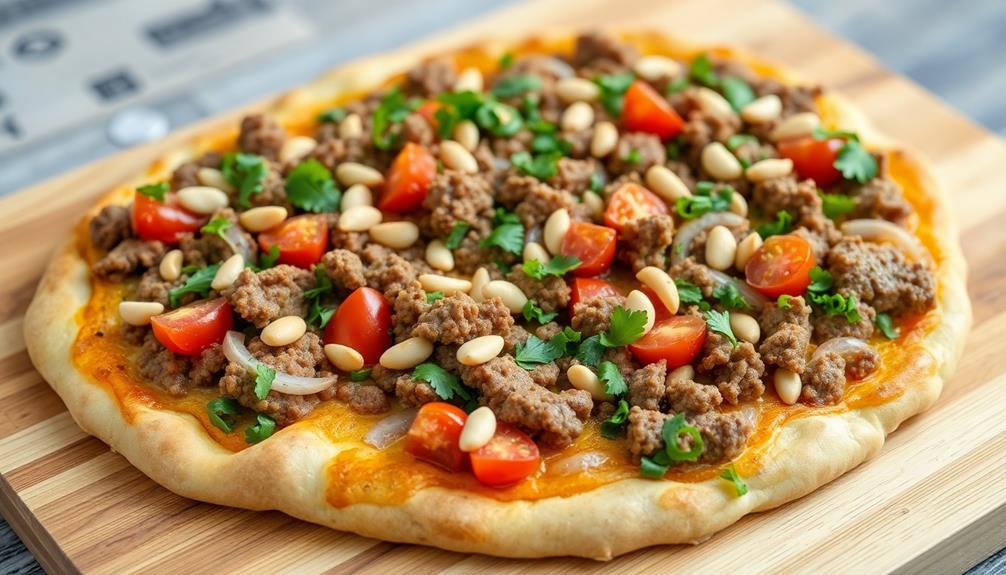Bamia, or okra stew, has ancient roots tracing back to the Nile River civilizations. Archaeologists have found okra seeds dating back to the 12th century BCE in ancient Egypt. As bamia traveled across the Middle East and North Africa, it developed unique local flavors. The core ingredients – okra, tomatoes, and aromatic herbs – create a beloved comfort food. To make bamia, you'll chop onions, crush garlic, and add diced tomatoes, okra, and spices. After simmering, the stew develops a rich, creamy texture. This captivating okra dish is a true reflection of the region's culinary heritage – and there's more to discover about its fascinating origins.
Key Takeaways
- Bamia is an ancient okra-based stew with origins tracing back to civilizations along the Nile River in Egypt.
- The unique local flavors of bamia developed as the dish traveled across the Middle East and North Africa.
- Key ingredients in bamia include okra, tomatoes, and aromatic herbs, creating a beloved comfort food dish.
- The cooking process involves sautéing onions and garlic, adding tomatoes and okra, and simmering to achieve the desired texture and flavor.
- Bamia is recognized for its spice balance, slow simmering, and tender okra texture, making it a satisfying and inspiring culinary experience.
History
The origins of bamia, or okra stew, can be traced back to ancient civilizations along the Nile River. Historians believe this beloved dish has been nourishing people in the region for thousands of years. In fact, archaeologists have found evidence of okra seeds dating back to the 12th century BCE in ancient Egypt.
As the dish traveled across the Middle East and North Africa, it took on unique local flavors. Today, bamia is a staple in many cuisines, from Lebanon to Sudan. Each region puts its own spin on the classic recipe, using different spices, vegetables, and cooking methods.
But no matter where you go, the core ingredients – okra, tomatoes, and aromatic herbs – remain the same.
Bamia has become a beloved comfort food, passed down through generations. Its hearty, savory flavors and vibrant color make it a true delight for the senses.
Whether you're enjoying it as a main course or a side dish, this historic stew is sure to warm your soul.
Cooking Steps
To begin, preheat your oven to 375°F (190°C).
In a large pot, sauté the onions in olive oil over medium heat until they're nice and soft. Next, add the garlic and stir for a minute or two until it's fragrant.
Now, toss in the diced tomatoes, vegetable broth, and okra. Bring the mixture to a boil, then reduce the heat and let it simmer for about 15 minutes. This will allow the flavors to meld together beautifully.
Once the okra is tender, stir in the lemon juice and season with salt and pepper to taste.
For a creamy texture, you can use an immersion blender to puree part of the stew.
Step 1. Chop Onions Into Small Pieces

Next, chop the onions into small, evenly-sized pieces. This is an important step, as you want the onions to cook down quickly and become nice and tender.
Use a sharp knife and carefully slice the onion in half from the root end to the stem end. Lay the flat side down on the cutting board, then slice the onion into thin, crescent-shaped strips.
Finally, turn the onion strips and chop them crosswise into small, diced pieces. You're aiming for onion bits that are about 1/4 inch in size. This will help them blend seamlessly into the stew.
Be mindful of your fingers – go slow and keep them curled under to avoid any accidental nicks. Once the onions are all chopped, you're ready to add them to the pot and let them sizzle.
Their savory aroma will start to fill the kitchen, getting you even more excited for the delicious Bamia to come!
Step 2. Peel and Crush Garlic Cloves

After chopping the onions, the next step is to peel and crush the garlic cloves. This step is crucial for building the flavor foundation of your Bamia (Okra Stew).
Grab a few plump garlic cloves and place them on a cutting board. Using the flat side of a sturdy knife, gently press down on each clove to crush it. This action will release the pungent, aromatic oils that give garlic its distinctive flavor.
Once crushed, use your fingers to peel away the papery skins. Be careful not to let any of the precious garlic go to waste!
With the garlic prepared, you're one step closer to creating a fragrant and delicious Bamia stew. The crushed garlic will infuse the oil and other ingredients, adding depth and complexity to the overall dish.
Take a moment to inhale the enticing aroma – your taste buds are about to be treated to something special!
Step 3. Add Chopped Tomatoes

With the aromatic garlic now ready, it's time to introduce the chopped tomatoes to the mix. Grab a few ripe, juicy tomatoes and give them a good chop. You want them in bite-sized pieces, not too big or too small. Toss the chopped tomatoes right into the pot with the sizzling garlic. The tomatoes will release their tangy, sweet juices, adding depth and flavor to the stew.
As the tomatoes mingle with the garlic, you'll start to notice the aroma intensifying. The stew is really coming together now! Stir the mixture gently, making sure the tomatoes get evenly distributed.
Let the flavors meld for a few minutes, allowing the tomatoes to soften and the garlic to infuse the entire dish. The bright, tomatoey notes will complement the okra perfectly, creating a harmonious blend of tastes and textures.
Get ready for your kitchen to be filled with the irresistible scent of this savory stew!
Step 4. Add Okra Slices

With the tomatoes now simmering in the pot, it's time to add the star ingredient – the okra.
Grab a bundle of fresh, green okra and give it a good rinse under cool water. Slice the okra into bite-sized pieces, around 1/2 inch thick. Carefully add the sliced okra to the pot, making sure to distribute them evenly throughout the stew.
As the okra hits the hot liquid, you'll notice it starts to release a slightly thickening, gooey texture. This is normal and actually helps create the signature creamy consistency of the bamia stew.
Let the okra simmer for about 10-15 minutes, allowing it to become tender and fully incorporate into the dish. The okra will soak up all the wonderful flavors from the tomatoes, onions, and spices, transforming into a delectable and nourishing component of this authentic Middle Eastern recipe.
Get ready for the aroma to fill your kitchen – it's going to be mouthwatering!
Step 5. Add Spices and Simmer

Now that the okra has been added, it's time to season the stew. First, add a teaspoon of ground cumin and a teaspoon of paprika. These spices will lend the stew a warm, earthy flavor.
Next, sprinkle in a pinch of cayenne pepper – just enough to give the dish a subtle kick. Don't worry, it won't be too spicy!
Now, let's add a tablespoon of tomato paste. This will thicken the stew and give it a nice, rich color.
Finally, pour in a cup of broth, enough to cover the vegetables. Bring the whole thing to a gentle simmer and let it cook for about 20 minutes. As it simmers, the flavors will meld together beautifully.
Keep an eye on the stew, stirring occasionally, until the okra is tender and the sauce has thickened. The longer it simmers, the more the flavors will develop.
Now your Bamia (Okra Stew) is well on its way to being a delicious, fragrant masterpiece!
Final Thoughts
Bamia, the captivating okra stew, has undoubtedly captured the culinary hearts of many. This aromatic and flavor-packed dish is more than just a meal – it's a delightful journey through the vibrant spices and textures of Middle Eastern cuisine. For those who have yet to experience the wonders of Bamia, they are in for a treat. The tender okra, stewed with tomatoes, onions, and a blend of aromatic spices, creates a rich and satisfying dish that pairs perfectly with a side of fluffy rice or warm pita bread. For a truly authentic Middle Eastern meal, Bamia can be accompanied by a traditional white bean stew recipe, adding even more depth and variety to the culinary experience.
As you've learned, the key to a perfect bamia lies in the perfect balance of spices, the slow simmering, and the tender, almost silky texture of the okra.
Now, as you savor the final product, take a moment to appreciate the care and attention that goes into every bite. The richness of the tomatoes, the warmth of the spices, and the satisfying crunch of the okra all come together to create a truly remarkable experience.
Whether you enjoy it on its own or paired with fragrant rice, bamia is a dish that will leave you feeling satisfied and inspired.
Frequently Asked Questions
What Are the Health Benefits of Eating Okra?
Okra is an amazing vegetable packed with nutrients!
It's loaded with fiber, which helps keep your digestive system happy and healthy. Plus, it's got vitamins A and C, which boost your immune system and help your body fight off sickness.
Okra's also got antioxidants that can lower your risk of heart disease and cancer.
Can I Substitute Other Vegetables for Okra in the Stew?
Absolutely! You can definitely substitute other veggies in your stew. Okra's got great health benefits, but if you're not a fan, no problem.
Try swapping in some zucchini, eggplant, or even tomatoes – they'll all work wonderfully. Just be sure to adjust the cooking time as needed.
The key is finding vegetables you enjoy and that complement the other flavors in the stew. Get creative and have fun with it!
How Long Does the Stew Stay Fresh in the Refrigerator?
Your delicious stew will stay fresh in the fridge for 3-4 days!
Just pop it in an airtight container, and it'll be ready for you to enjoy whenever you need a tasty, comforting meal.
The flavors will only get better as the stew sits, so you can make a big batch and have it on hand all week.
Isn't that exciting? Grab a spoon and dig in!
Can I Make the Stew Vegetarian by Omitting the Meat?
Absolutely! You can easily make the stew vegetarian by leaving out the meat.
It'll still be super tasty and satisfying. Just swap in some extra veggies or plant-based protein like chickpeas or lentils.
You'll get all the same great flavors without the meat. It's a great way to make the dish work for any diet.
Give it a try – you'll be amazed at how delicious it can be!
Is It Possible to Freeze the Leftover Okra Stew?
Sure, you can definitely freeze leftover okra stew!
In fact, it's a great way to save some for later. Just let the stew cool completely, then transfer it to an airtight container or freezer bag.
When you're ready to enjoy it again, simply thaw it in the fridge overnight and reheat it on the stove.
The frozen stew will stay fresh for up to 3 months, so you can savor that delicious flavor anytime.
It's an easy way to make the most of your leftovers!









